人教版新目标英语七年级下册新教材unit8课件
- 格式:ppt
- 大小:1.86 MB
- 文档页数:47

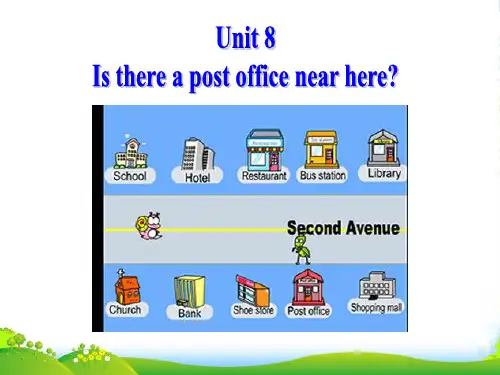

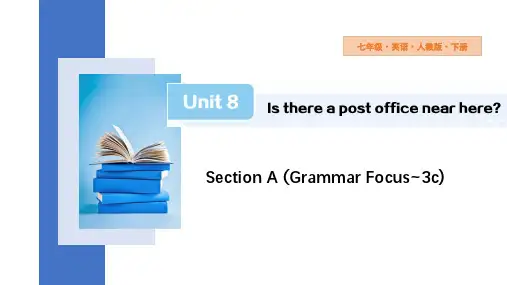


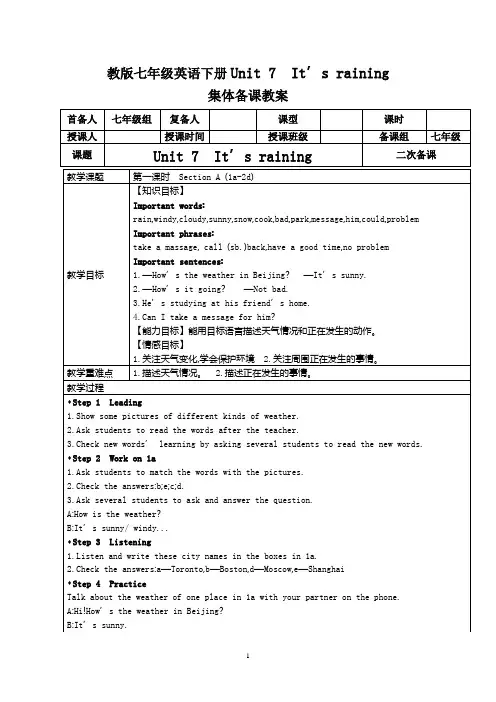
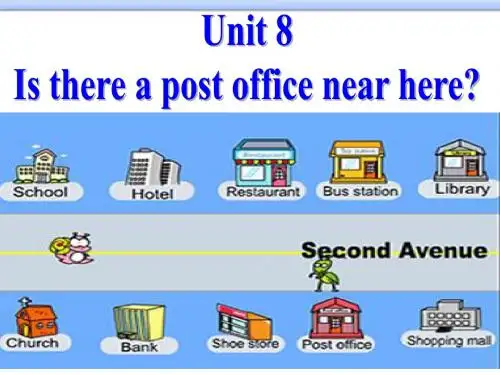
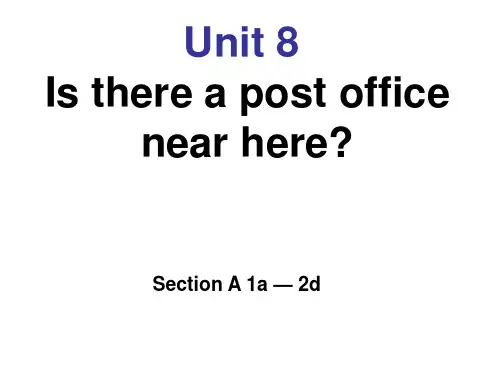


七年级英语Unit 8 When is your birthday? 人教版(新目标)【本讲教育信息】一. 教学内容:Unit 8 When is your birthday?二. 单元知识梳理:三. 疑难解析1. when引出的特殊疑问句when是一个疑问副词,意为:什么时候,何时,引出一个特殊疑问句。
when可以对年、月、日以及时刻进行提问或者询问某一动作发生的时间,回答时常用介词at, in, on等组成的表时间的介词短语。
例如:—When is your birthday?你的生日是什么时候?—My birthday is / It’s July 16th.我的生日是七月十六日。
—When do you go to school every day?你每天什么时候去上学?—I go to school at 6:30 every day.我每天6:30上学。
—When will your parents e to see you?你父母什么时候来看你?—On Sunday.星期天。
另外,除了when之外,还可用what time就时间进行提问,what time更强调“几点”。
如:—What time is it? —It’s six o’clock.现在几点钟?六点钟。
2. What year were you born?你出生于哪一年?what year表示对年代提问,相当于疑问副词when,所以该句也可用when提问:When were you born?当然用what year提问强调是哪一年出生的。
be born出生。
当我们说某人出生于某时或某地时,总是用一般过去时,即was / were born, was是am, is的过去式,were是are的过去式。
例如:—Where were you born?你出生于哪儿?—I was born in Wuhan.我出生于某某。
—When was your sister born?你的妹妹是什么时候出生的?—She was born on March 11th, 1990.她出生于1990年3月11日。
Unit8 Is there a post office near here?1.Is there a hospital near here?辨析: near&next tonear:(prep) 在...附近(adj)近的Eg:There is a park near my house.It is near from my house to school.next to:(介词短语)贴近;紧靠相当于close to/beside Eg:The park is next to my school.2.The pay phone is in front of the library.辨析:in front of &in the front ofin front of :(外部)在...前面in the front of :(内部) 在...前面Eg:The car is in front of the house.The driver is sitting in front of the car.辨析:before&in front of(1)表示位置关系:在...之前,二者可以通用Eg:She sits before /in front of me.(2)表示时间、次序时,只能用before.Eg:The worker must finish the task before Wednesday.3.The pay phone is behind the library.辨析:behind&afterbehind:在...后面(位置关系)in front of (反义词)Eg:The hospital is behind the post office.after :在...之后(时间、次序)Eg:He wants to play games after 5p.m.4.Is there a bank around here?around:(prep)在...周围(adv)在各处;到处;环绕Eg:There are some beautiful flowers around the garden.My dream is to travel around the world.around:大约相当于aboutEg:There are around 70 students in our class.5.Is it next to the police station?police station:警察局Police:(集体名词)作主语时,谓语动词用复数形式Eg:The police are ing.注意: “一名警察”不能写成:a police应该写成:a policeman/a policewoman对应复数形式为:some policemen /some policewomen6.Just go along Bridge Street and turn left/right when you see the library.along:(prep)沿着常与walk/go连用,沿着...走Eg:Walk /Go along the street and you will find the library.along:(adv) 构成短语:all along 一直 e along 与...一起来get along with 与...相处left/right (adv/n /adj) 向左/右;左/右边;左/右边的turn left/right (中间不要冠词the)turn to left/right (此时为n)on the left/right 在左/右边on one’s left/right 在某人的左右边in his left/right 在他的左/右手里7.There is a zoo in my neighborhood.in the neighborhood 在附近= near herein the neighborhood of 在...附近Eg:There is a supermarket in the neighborhood of the bank.构词法:neighbor(邻居)+hood=neighborhood(街区)child+hood=childhood(童年)8.I like to spend time there on weekends.辨析:spend cost pay takeSpend:(主语是人)花费(1)人+spend+时间/金钱+on sth. 某人在...上花费时间/金钱(2)人+spend+时间/金钱+(in) doing sth. 某人花费时间/金钱做某事Eg:He spent fifty yuan on the new book.My sister spends two hours watching TV.Cost:(主语是物) 花费物+cost+(人)+金钱某物花了某人多少钱Eg:The book costs her fifty yuan .Pay:(主语是人)支付人+pay +(人)+金钱+for sth. 某人(向某人)支付多少钱买某物Eg:She pays fifty yuan for the book.Take:常用it作形式主语It takes sb. +时间+to do sth. 花费某人时间做某事Eg:It takes me two days to finish my work.或:I spend two days finishing my work.9.I love to watch the monkeys climbing around.watch/see/hear sb.+ do sth. 强调动作的整个过程(动作已经发生) watch/see/hear sb.+ doing sth. 强调动作正在进行Eg:I often hear him sing that song.I hear him singing that song.I see a girl draw the picture under a tree.I see a girl drawing the picture under a tree.10.To get to the park,you just have to cross Center Street.To get to the park:动词不定式位于句首,作目的状语。
七年级英语下册新版人教新目标版Section A 第2课时(2a~3c)自主学习方案1.自学生词,并记住拼读及拼写。
2.预习课本找出重点短语及句子。
(见学案自学导练内容)3.读记后完成自学导练内容。
课堂导学方案Step1 情景导入展示图片,然后师生进行对话。
(最后利用多媒体课件)T:Is there a library near here?S:Yes,there is.T:Where is it?S:It’s on Green Street.T:Yes,it is on Green Street,and it’s across from the pay phone. Is there a hotel near here?S:Yes,there is.T:Where is it?S:It’s on Center Street.T:Yes,it is on Center Street,and it’s in front of the bank.环节说明:通过师生互动问答复习了上节课的内容,同时又引出了本节课要求掌握的介词短语。
Step 2完成教材2a—2c的任务1.大声朗读2a的句子并标出其中的介词短语识记。
(3分钟)2.认真观察图片,将句子和图片匹配,小组订正答案,完成2a。
(3分钟)3.识记方框中的表示方位的词或短语,然后认真听录音,完成选词填空,集体核对答案。
学生识记句型,体会表示方位的介词或介词短语的用法,完成 2b。
(3分钟)4.根据43页1a图片上的建筑物位置,仿照2c形式来练习对话。
两人一组,根据图片和提示,自编对话,注意交换角色。
(5分钟)5.小结训练。
(3分钟)用介词填空:(1)The library is across from the bank.(2)The bank is between the supermarket and the hospital.(3)My house is on that small street.(4)The restaurant is next to the park.(5)There is a beautiful park in front of the bank.环节说明:通过2a的学习让学生了解介词短语的用法,通过2b、2c的学习有助于提高学生的听力和口语能力。
说课稿一、教材分析(一)、教材的地位和作用本课是人教版新目标英语七年级下册Uni t 8 I’d like some noodles.第一课时。
本单元的中心话题是如何在饭店订餐以及进行简单的广告或海报的简单写作方式,本课时是要掌握点餐(面条,饮料等的种类及碗的大小)。
主要语言结构为:掌握would like的用法,列出具体句型。
通过本课的学习进一步培养学生的跨文化意识和综合语言运用能力。
(二)、教学目标1、知识与能力目标(1)、语言知识目标:通过学习是学生掌握并能熟练运用四会三会词语、句型,并对可数名词和不可数名词的进一步学习与区分。
Words: noodlebeef cabbage potatospecial size bowl muttonSentenc es: What kind of noodles would you like? / What size bowl of noodles would you like?I’d like some ….(2)、语言技能目标:能运用所学词汇、句型点餐,能在真实情景中熟练运用。
2、过程与方法目标:培养学生自主学习的能力、语言综合运用能力、听力、英语会话能力、与他人合作的能力。
3、情感态度与价值观目标:通过创设人文情景,学生身临其境感受和体验,使语言学以致用,做到“在用中学,在学中用”,激发学生的学习积极性。
体会在活动中学习英语的乐趣。
培养学生乐于与他人合作的精神及养成科学的饮食习惯。
4、文化意识目标:通过对中、西方在饮食及用餐方面异同的对比,对祖国饮食文化能有更深刻的了解。
乐于了解异国文化,加强对文化差异的理解与认识。
5、学习策略目标:通过学习,是学生在一定程度上形成自主学习、探究学习、合作学习的习惯,有效交际、用英语思维的能力。